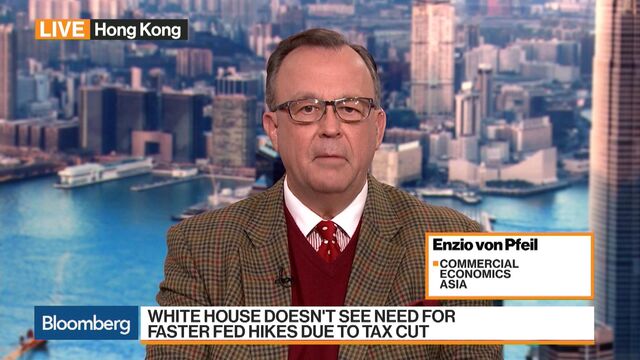Fed's Monetary Policy Cornerstone Attacked at Economists' Gathering

Betting on the Pace of Fed Rate Hikes
Milton Friedman put a nail in the coffin of the original version of the Phillips Curve 50 years ago when he correctly foresaw that the U.S. could simultaneously suffer from high unemployment and lofty inflation. A growing number of economists are now trying to lay to rest Phillips Curve 2.0, still in use at the Federal Reserve and other central banks to guide monetary policy.
At the Jan. 5-7 annual meeting of the American Economic Association in Philadelphia, economists questioned the usefulness of a cornerstone concept in mainstream economics that links changes in inflation to fluctuations in joblessness.
“The Phillips Curve is a terrible idea,’’ said Robert Hall, a professor at Stanford University in California who also heads the recession-dating committee of the National Bureau of Economic Research.
Skepticism about the Phillips Curve is significant because the Fed and other major central banks are counting on declines in unemployment to foster faster wage increases and lift inflation that they deem to be too low. Indeed, it’s the major rationale behind the U.S. central bank’s plan to keep raising interest rates. If the curve is broken, it’s unclear what lodestar monetary policy makers would adopt to help guide inflation back up to target.
Trade-Off Challenged
In his 1967 presidential address to the economists’ annual convention, Friedman challenged the prevailing dogma of the time -- that central banks could micromanage the economy and choose to trade off higher inflation today for a permanently lower level of unemployment.
In response to his criticisms -- and the stagflation that afflicted the U.S. economy in the 1970s -- the Phillips Curve was modified to include the idea of a natural rate of joblessness: if unemployment fell below that level, inflation would continue to accelerate. The theorem also now includes a prominent role for inflation expectations, the idea being that if consumers and businesses expect price rises to pick up, they will act in ways that will bring that about.

The trouble is that even the re-jigged version of the theory is so far not panning out in practice. At 4.1 percent in December, the U.S. unemployment rate was markedly below the 4.6 percent level that Fed policy makers reckon is equivalent to its natural rate. Yet underlying inflation this year has decelerated, not accelerated, and price gains remainbelow the Fed’s 2 percent goal.
That’s led some inside the central bank to question the Fed’s strategy. “I don’t really think we’re getting the kinds of Phillips Curve effects that people still emphasize,” James Bullard, president of the Federal Reserve Bank of St. Louis, said in a Jan. 5 Bloomberg Television interview with Michael McKee on the fringes of the AEA meeting.
‘Very, Very Small’
Bullard, who currently sees no need for further Fed rate increases, said the inflationary effects of lower joblessness as posited by the Phillips Curve are either “nonexistent’ or “very, very small.’’
While Bullard is an outlier at the central bank -- none of his colleagues agree that they should call off their rate-hiking campaign, and their median projection calls for three increases in 2018 -- even some more traditionally-inclined economists are starting to have doubts about the Phillips Curve.
Yellen Defense
Former Fed Vice Chairman Stanley Fischer responded vigorously at the conference to Hall’s criticisms -- at one point asking the Stanford University professor if he thought Fed Chair Janet Yellen was wasting her time trying to manage the economy -- yet he seemed to concede that the theorem didn’t seem to be performing as expected.
“The Phillips Curve has less value in the modern world because it doesn’t work anymore,” he said.
Olivier Blanchard, who’s taking over as president of the AEA this year, provocatively asked whether the natural unemployment rate hypothesis put forward by Friedman half a century ago should be rejected.
The International Monetary Fund’s former chief economist saw what he called “suggestive” evidence that policy makers might be able to push joblessness below what is seen as its natural rate without risking higher inflation.
So what does that mean for the Fed? “There is a decent case” it should overheat the economy and try to attract more people into the labor force, said Blanchard, now a senior fellow at the Peterson Institute for International Economics in Washington.
— With assistance by Michael McKee, Jeanna Smialek, and Christopher Condon
Before it's here, it's on the Bloomberg Terminal.LEARN MOREHave a confidential news tip?Get in touch with our reporters.Most Read